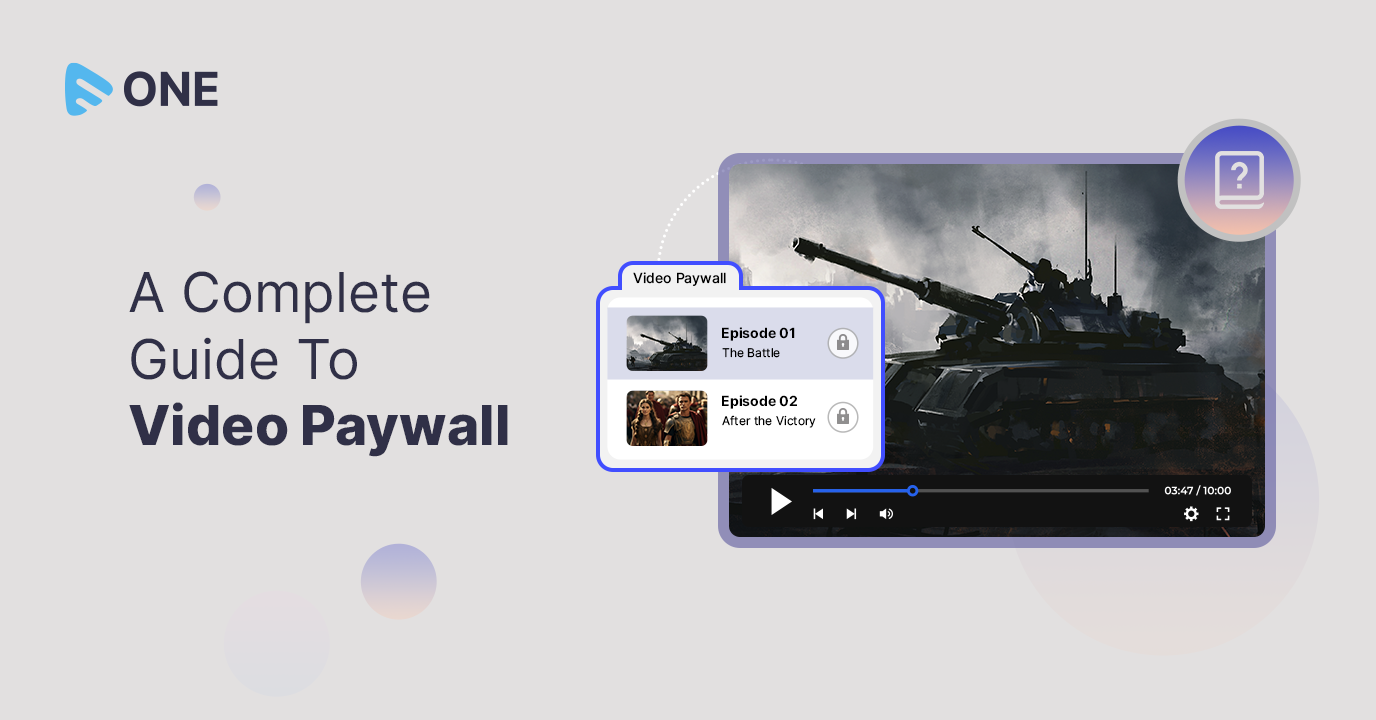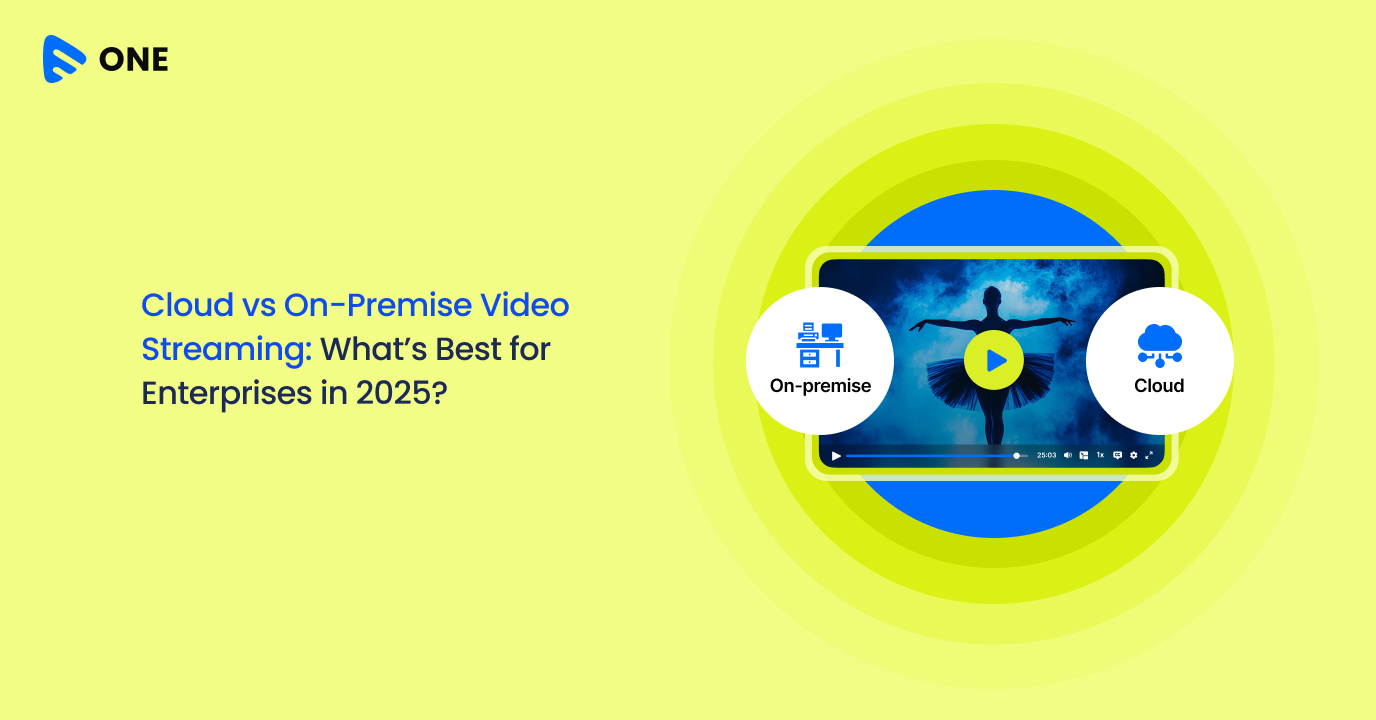Be it live streaming or video on demand – the streaming industry is continually evolving, making it essential for businesses in this sector to grasp the significance of various crucial components. And video paywall is one of them.
A clear understanding of video paywalls is crucial as they serve as a pivotal mechanism for revenue generation and content monetization. By implementing effective paywall strategies, streaming platforms can not only secure a steady stream of income but also offer incentives for users to subscribe or make purchases, thus strengthening customer loyalty and engagement.
Video paywalls enable businesses to tailor their content offerings and pricing models to meet the diverse preferences and expectations of their audience. In a competitive marketplace where consumers have a plethora of options, leveraging video paywalls empowers streaming businesses to differentiate themselves, optimize user experience, and ultimately drive sustainable growth and profitability.
Wondering how? Read on, as we walk you through all you need to know about video paywall.
What Is Video Paywall?
A video paywall refers to a digital barrier implemented by content creators or streaming platforms to restrict access to premium video content. It serves as a mechanism for monetizing video content by requiring users to pay a subscription fee, purchase individual titles, or adhere to other payment models before accessing the desired videos.
Video paywalls are designed to strike a balance between offering a certain amount of content for free to attract users and enticing them to pay for access to exclusive or premium content. They are often used by media companies, content creators, and streaming platforms to generate revenue, recoup production costs, and sustain their operations in the digital landscape.
The implementation of video paywalls can vary depending on the specific business model and objectives of the content provider. Some paywalls operate on a subscription basis, where users pay a recurring fee for unlimited access to a library of video content. Others may adopt a pay-per-view model, allowing users to purchase access to individual videos or live events.
How To Implement a Video Paywall?
1. Paywall Setup: Initial Configuration Steps
The process of setting up a video paywall involves several intricate steps, beginning with the selection of an appropriate platform or service provider. Businesses must conduct thorough research to identify a platform that aligns with their specific requirements and objectives. Factors to consider include pricing, features, scalability, customization options, and integration capabilities with existing systems.
Once a platform is chosen, the account setup process begins. This involves creating an account, providing necessary information, and configuring basic settings. Users must define key parameters such as pricing tiers, subscription options, access levels, and content restrictions.
Furthermore, businesses need to establish policies regarding free trials, promotional offers, and discounts. These policies play a crucial role in attracting users and encouraging subscription conversions while maximizing revenue potential. Careful consideration should be given to the duration, eligibility criteria, and redemption methods of promotional offers to ensure they align with business goals.
Throughout the setup process, businesses should prioritize security and compliance. This includes implementing robust authentication mechanisms, encryption protocols, and data protection measures to safeguard user information and prevent unauthorized access.
2. Content Selection: Choosing Videos for Paywall
Content selection is a critical step of implementing a video paywall, as it directly impacts user engagement, retention, and revenue generation. You must carefully curate and select premium or exclusive content that offers unique value to their target audience.
The content selection process begins with a thorough analysis of audience preferences, interests, and viewing habits. Businesses should leverage data analytics tools and audience insights to identify high-demand content categories, trending topics, and popular genres.
Additionally, businesses should consider the production quality, relevance, and exclusivity of the content when making selection decisions. Premium content may include original series, exclusive interviews, behind-the-scenes footage, live events, and archival footage.
Furthermore, you need to prioritize diversity and variety in their content offerings to cater to different audience segments and demographics. This may involve sourcing content from a variety of sources, collaborating with content creators, or acquiring licensing rights for third-party content.
3. Payment Integration: Linking Payment Gateways
Integration with payment gateways is a fundamental pillar of implementing a video paywall, as it enables businesses to process transactions and collect payments from users seamlessly. Popular payment gateways such as PayPal, Stripe, Square, and Authorize.Net offer secure and reliable payment processing solutions that support a variety of payment methods, including credit cards, debit cards, digital wallets, and bank transfers.
The integration process typically involves creating an account with the chosen payment gateway provider and configuring the necessary settings to enable payment processing. This may include setting up merchant accounts, configuring payment methods, and defining pricing structures.
Once the payment gateway is integrated with the video paywall platform, businesses must ensure that payment transactions are secure, compliant with industry standards, and user-friendly. Implementing features such as one-click payments, auto-renewal options, and payment reminders can help streamline the user experience and increase conversion rates.
You need to regularly monitor payment transactions, analyze payment data, and optimize payment processes to minimize transaction failures, reduce payment processing costs, and maximize revenue potential.
4. User Authentication: Creating Access Credentials
You must implement robust authentication mechanisms to verify user identities, prevent unauthorized access, and protect sensitive information.
There are several authentication methods that businesses can leverage, including:
- Username and password authentication: Users create unique login credentials (username and password) to access the paywalled content.
- Email verification: Users receive a verification email with a unique link to verify their email address and activate their account.
- Single sign-on (SSO) authentication: Users can log in using their existing credentials from third-party identity providers, such as Google, Facebook, or Apple.
You need to carefully evaluate the pros and cons of each authentication method based on factors such as security, user experience, and scalability.
In addition to authentication, you must implement security measures such as encryption, multi-factor authentication (MFA), and IP whitelisting to protect user data and prevent unauthorized access or account breaches. Regular security audits and vulnerability assessments can help identify and mitigate potential security risks.
5. Paywall Design: Customizing User Interface
The design and user interface (UI) of a video paywall play a significant role in shaping the user experience and influencing user engagement, conversion rates, and brand perception. Businesses must prioritize usability, accessibility, and aesthetics when customizing the paywall UI to create a seamless and intuitive browsing experience for users.
Key elements of paywall design customization include:
- Branding and visual identity: Businesses should incorporate brand elements such as logos, color schemes, typography, and imagery to create a cohesive and visually appealing paywall interface that reflects the brand’s identity and personality.
- Navigation and information architecture: The paywall interface should feature intuitive navigation menus, clear hierarchies, and logical information architecture to help users easily discover, browse, and access content.
- Calls-to-action (CTAs) and conversion elements: You should strategically place CTAs, subscription buttons, pricing information, and promotional offers throughout the paywall interface to encourage user engagement and drive subscription conversions.
- Responsive design and cross-device compatibility: The paywall interface should be optimized for a wide range of devices and screen sizes, including desktops, laptops, tablets, and smartphones. Implementing responsive design principles ensures that the paywall interface adapts seamlessly to different devices and resolutions.
- User feedback and usability testing: Businesses should gather feedback from users through surveys, focus groups, and usability testing to identify pain points, usability issues, and areas for improvement in the paywall interface. Iterative design enhancements based on user feedback can help optimize the user experience and increase user satisfaction.
6. Analytics Tracking: Monitoring Viewer Engagement
Analytics tracking is an essential component of implementing a video paywall, as it provides valuable insights into viewer behavior, engagement patterns, and subscription metrics. By leveraging analytics tools and data-driven insights, businesses can optimize their paywall strategy, enhance user experience, and maximize revenue potential.
Key performance indicators (KPIs) that businesses should track and analyze include:
- Conversion rates: The percentage of visitors who subscribe to the paywall or make a purchase.
- Churn rates: The percentage of subscribers who cancel their subscription or churn out of the paywall.
- Average revenue per user (ARPU): The average amount of revenue generated per user over a specific period.
- Subscriber retention rates: The percentage of subscribers who remain active and continue their subscription over time.
- Engagement metrics: Viewer interactions with paywall content, including video views, watch time, clicks, shares, and comments.
Analytics tracking tools such as Google Analytics, Adobe Analytics, and custom tracking solutions can help businesses collect, analyze, and visualize data related to these KPIs. By segmenting audiences, analyzing user behavior, and identifying trends and patterns, businesses can gain actionable insights into audience preferences, content performance, and subscription behaviors.
Furthermore, businesses can leverage A/B testing, cohort analysis, and predictive modeling techniques to experiment with different paywall strategies, optimize conversion funnels, and personalize user experiences based on individual preferences and behaviors.
7. Support & Maintenance: Ensuring Paywall Functionality
Once a video paywall is implemented, it’s essential to provide ongoing support and maintenance to ensure its functionality, reliability, and performance. Paywall support and maintenance activities include:
- Technical support: Establish a dedicated support team or helpdesk to address user inquiries, troubleshoot technical issues, and provide assistance with subscription management, payment processing, and account-related matters.
- Software updates and patches: Regularly update the paywall platform, content management system (CMS), and third-party integrations to ensure compatibility, security, and performance. Install security patches, bug fixes, and software updates promptly to mitigate vulnerabilities and safeguard against potential security threats.
- Performance monitoring and optimization: Monitor the performance and reliability of the paywall infrastructure, including server uptime, response times, and page load speeds. Conduct performance tests, stress tests, and load tests to identify bottlenecks, optimize system performance, and ensure scalability to accommodate growing user demand and traffic spikes.
- Compliance and security audits: Conduct regular audits and assessments to ensure compliance with industry standards, regulatory requirements, and data protection laws. Implement security measures such as encryption, access controls, and data encryption to protect user data and prevent unauthorized access or data breaches.
- User feedback and continuous improvement: Gather feedback from users through surveys, reviews, and user feedback channels to identify areas for improvement, usability issues, and feature requests. Prioritize user feedback and incorporate user-driven enhancements into future updates and iterations of the paywall platform.
- Training and documentation: Provide training resources, documentation, and knowledge base articles to help users navigate the paywall interface, troubleshoot common issues, and maximize the value of their subscription. Offer tutorials, webinars, and online courses to educate users on paywall features, subscription options, and content offerings.
By prioritizing support and maintenance activities, businesses can ensure a positive user experience, minimize downtime, and maximize the effectiveness of their video paywall implementation.
Types of Video Paywalls
1. Subscription Model: Recurring Payments
The subscription model ensures a steady stream of revenue for content creators and platforms while offering subscribers convenience and flexibility in accessing premium content.
Subscription-based video streaming platforms typically offer multiple subscription tiers, allowing users to choose a plan that best fits their budget and viewing preferences. Higher-tier plans often come with additional features such as ad-free viewing, offline downloads, and access to exclusive content.
One of the key advantages of the subscription model is its ability to boost customer loyalty and retention. By offering a compelling selection of content and continuously updating their libraries with new releases and exclusive offerings, subscription-based platforms can keep subscribers engaged and subscribed over the long term.
2. Rental System: Temporary Access
The rental system, also known as video-on-demand (VOD) rental, allows users to rent individual titles for a limited period. This pay-per-view model offers users the flexibility to watch specific content without committing to a subscription.
Rental fees vary depending on factors such as the title’s popularity, release date, and video quality. New releases and blockbuster titles typically command higher rental prices, while older or less popular titles may be available at discounted rates.
The rental system is ideal for users who prefer to watch specific movies or shows on-demand without the long-term commitment of a subscription. It allows users to enjoy the latest releases without waiting for them to become available on subscription-based platforms.
3. One-Time Purchase: Lifetime Access
In the one-time purchase model, users pay a single fee to permanently own a specific title. Once purchased, users can access the content anytime, anywhere, without expiration or time limitations.
This model is popular among users who want to build a digital library of their favorite movies and shows. It offers convenience and flexibility, allowing users to watch their purchased content across multiple devices and platforms.
Streaming businesses benefit from the one-time purchase model by generating revenue from individual sales while retaining ownership rights to their content. Users have the assurance of permanent access to their purchased titles, making it a compelling option for collectors and enthusiasts.
4. Ad-Supported: Free with Ads
The ad-supported model offers free access to video content supported by advertising revenue. Users can watch videos, movies, and shows for free, with ads displayed at intervals during playback.
Ad-supported platforms leverage targeted advertising to deliver relevant ads to users based on their interests, demographics, and viewing behavior. This model allows platforms to monetize their content while providing free access to users.
Such platforms may offer premium subscription options to users who prefer an ad-free experience. Premium subscribers enjoy uninterrupted viewing without ads, providing an additional revenue stream for platforms.
5. Freemium Option: Basic Access Free
The freemium model offers a combination of free and premium content, with basic features available to users at no cost. Premium features and additional content are locked behind a paywall, requiring users to upgrade to a premium subscription to access them.
Freemium platforms aim to attract users with free content offerings while enticing them to upgrade to a premium subscription for enhanced features and exclusive content. This model allows platforms to monetize their user base while providing value to both free and paying users.
The Bottom Line
Undoubtedly, utilizing a video paywall to host your content ensures that you retain complete control over access to your valuable content. By employing a VOD streaming platform with a robust video paywall solution like Muvi One, you safeguard your business from the uncertainties of external algorithms. Muvi One’s robust streaming solution offers a secure video paywall feature, ensuring that your premium content remains protected from unauthorized access.
Take a 14-day free trial to experience firsthand how our video streaming solution can fortify your content security measures and preserve the integrity of your business. With Muvi One, you can confidently curate and stream your content while maintaining control over who can access it.

















Add your comment